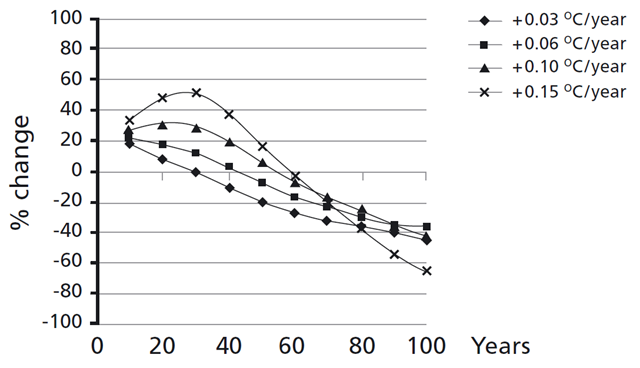Graph of the Day: Predicted Indus River Flows Under Four Warming Scenarios
Predicted patterns of Indus flows above Tarbela with changes in snow-melt patterns and volume under climate change (World Bank Pakistan Country Water Assistance Strategy, 2005, quoting Rees and Collins, 2006) Forward predictions, as shown in the graph, should see a mid-term increase in annual average runoff (consistent with mass balance) and/or an increase in groundwater recharge (Rees and Collins, 2006). However, it is not clearly documented yet and the fact of declining flows in major rivers is counter-intuitive. In Central Asia, there is emerging evidence in the Fergana system in the form of increased mudflows from the Tien Shan Mountains and new periods of late season melt and mudflows (Raivodhkhoz, Osh, Kyrgizstan, personal communication, 2007). Given the importance of snowmelt to irrigation supplies throughout the sub-Himalaya (India, Pakistan, Bangladesh, Vietnam and China) and other mountainous regions in the United States (Rocky Mountains) (USDA, 2008), the Andes and Central Asia (Tien Shan), further analysis and research is required. A key issue is to improve the monitoring of flows and their variability and the closure of snowmelt water balances. Remote sensing (especially synthetic aperture radar) offers effective, frequent and relatively cheap means of monitoring glacier area and snow cover, but better temperature, precipitation and flow data will be needed to help understand the processes involved, especially in flow paths between glaciers, rivers and aquifers. The main puzzle for Chinese scientists investigating the Qing Hai source flows is the hydrological behaviour of the frozen ground in the plateau. As far as snowmelt is concerned, changes in the amount of precipitation tend to affect the volume of runoff while temperature mostly changes the timing of the runoff (Barnett et al., 2005). Increasing temperatures lead to earlier runoff in the spring or winter and reduced flows in summer and autumn. Furthermore, where temperatures rise such that the melt quantities exceed precipitation, ice deposits will decline both spatially and in terms of their ability to supply downstream needs. This is already happening, with glacial retreat in evidence almost everywhere. The knock-on effect is already apparent in large river systems and is expected to affect more, especially the large Asian drainage basins that depend on the Himalayan Ice, and in which much of the world’s large-scale irrigation is situated. Runoff does indeed occur earlier in the season and peak earlier, requiring a gradual shift in the cropping season. In some places this may be beneficial, if supplies peak ahead of monsoon rains, supply may in fact be more consistent, although it will encourage use when crop water demands are highest and possibly least efficiently used. Barnett (2005) suggests that one sixth of the world’s population lives in areas that are or will be affected by declining snowmelt and changing hydrographs; one quarter of global GDP is generated in these areas, which include much of North America.
